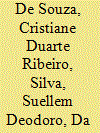|
|
|
Sort Order |
|
|
|
Items / Page
|
|
|
|
|
|
|
| Srl | Item |
| 1 |
ID:
162956


|
|
|
|
|
| Summary/Abstract |
To study the effect of the air pollution charging fee (APCF) policy on the haze pollution in China, a dynamics management model is constructed with the approach of system dynamics and implemented by using the Vensim software. This model is used to simulate and assess the effect of APCF policy on the traffic and the emissions (particularly carbon monoxide (CO), hydrocarbons (HC), nitrogen oxides (NOx), and particulate matter (PM)) in Beijing during the years 2011–2025 in different scenarios. The validity and the robustness of the model are verified by a model test and validation, and a reasonable range of APCF is determined by using a sensitivity analysis. The simulation results showed that the APCF policy effectively realized the “win-win” scenario of emission reduction and congestion release. In particular, the simulation results also indicated some policy effects such as rebound effect (from low-APCF policy), inflection-point effect (from high-APCF policy), and marginal decreasing effect (between moderate and high-APCF policy). These results provide some valid policy recommendations for energy management and emission reduction.
|
|
|
|
|
|
|
|
|
|
|
|
|
|
|
|
| 2 |
ID:
117313


|
|
|
|
|
| Publication |
2013.
|
| Summary/Abstract |
Road transportation has contributed to increased emissions of conventional air pollutants and, consequently, to the increase in problems associated with the environment and human health, depending on the type of pollutant and the concentration of it. To support the development of public policies aimed to decrease total tonnes of emissions, we used a bottom-up approach to estimate the amount of air pollutants, such as carbon monoxide (CO), total hydrocarbons (THC), nitrogen oxides (NOx), particulate matter (PM), and aldehydes (RCHO), that are emitted by road transportation in the state of Rio de Janeiro (RJ) from 1980 to 2010. The results from 2010 show that cars are responsible for 55% of CO emissions, 61% of THC emissions, and 93% of RCHO emissions. Due to the use of hydrated ethanol and compressed natural gas (CNG) instead of petroleum based fuels during the period analyzed, 1,760,370 t of air pollutant emissions were avoided. Compared to Brazil, in 2010, RJ had a quantity of emissions per vehicle from 12% (CO) to 59% (PM) smaller than the national average. As strategies to reduce air pollutant emissions, we consider reducing the intensity of use, with a proportional reduction in emissions, and increased the use of biodiesel.
|
|
|
|
|
|
|
|
|
|
|
|
|
|
|
|
| 3 |
ID:
115650


|
|
|
|
|
| Publication |
2012.
|
| Summary/Abstract |
Past investigations have shown that the current type-approval test cycles are not representative for real-world vehicle usage. Consequently, the emissions and fuel consumption of the vehicles are underestimated. Therefore, a new cycle is being developed in the UNECE framework (World-harmonised Light-duty Test Procedure, WLTP), aiming at a more dynamic and worldwide harmonised test cycle. To provide recommendations for the new cycle, we have analysed the noxious emission results of a test programme of seven vehicles on the test cycles NEDC (New European Driving Cycle) and CADC (Common Artemis Driving Cycles). This paper presents the results of that analysis to show the zones of the cycle that are causing the highest emissions, using two different approaches. Both approaches show that the zones with the highest emissions of modern vehicles differ from vehicle to vehicle. Consequently, a representative test cycle has to contain as many combinations of vehicle speed and acceleration that occur in real-world traffic as possible to prevent that a vehicle does not perform well for certain combinations because they are not included in the test cycle. Furthermore, the paper demonstrates that it is important to include a cold start to ensure rapid warm up of the catalysts.
|
|
|
|
|
|
|
|
|
|
|
|
|
|
|
|
|
|
|
|
|